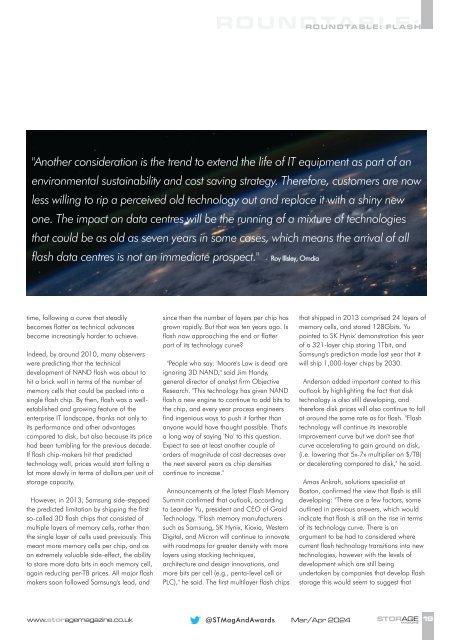ST2403
You also want an ePaper? Increase the reach of your titles
YUMPU automatically turns print PDFs into web optimized ePapers that Google loves.
ROUNDTABLE: FLASH<br />
"Another consideration is the trend to extend the life of IT equipment as part of an<br />
environmental sustainability and cost saving strategy. Therefore, customers are now<br />
less willing to rip a perceived old technology out and replace it with a shiny new<br />
one. The impact on data centres will be the running of a mixture of technologies<br />
that could be as old as seven years in some cases, which means the arrival of all<br />
flash data centres is not an immediate prospect." - Roy Illsley, Omdia<br />
time, following a curve that steadily<br />
becomes flatter as technical advances<br />
become increasingly harder to achieve.<br />
Indeed, by around 2010, many observers<br />
were predicting that the technical<br />
development of NAND flash was about to<br />
hit a brick wall in terms of the number of<br />
memory cells that could be packed into a<br />
single flash chip. By then, flash was a wellestablished<br />
and growing feature of the<br />
enterprise IT landscape, thanks not only to<br />
its performance and other advantages<br />
compared to disk, but also because its price<br />
had been tumbling for the previous decade.<br />
If flash chip-makers hit that predicted<br />
technology wall, prices would start falling a<br />
lot more slowly in terms of dollars per unit of<br />
storage capacity.<br />
However, in 2013, Samsung side-stepped<br />
the predicted limitation by shipping the first<br />
so-called 3D flash chips that consisted of<br />
multiple layers of memory cells, rather than<br />
the single layer of cells used previously. This<br />
meant more memory cells per chip, and as<br />
an extremely valuable side-effect, the ability<br />
to store more data bits in each memory cell,<br />
again reducing per-TB prices. All major flash<br />
makers soon followed Samsung's lead, and<br />
since then the number of layers per chip has<br />
grown rapidly. But that was ten years ago. Is<br />
flash now approaching the end or flatter<br />
part of its technology curve?<br />
"People who say: 'Moore's Law is dead' are<br />
ignoring 3D NAND," said Jim Handy,<br />
general director of analyst firm Objective<br />
Research. "This technology has given NAND<br />
flash a new engine to continue to add bits to<br />
the chip, and every year process engineers<br />
find ingenious ways to push it farther than<br />
anyone would have thought possible. That's<br />
a long way of saying 'No' to this question.<br />
Expect to see at least another couple of<br />
orders of magnitude of cost decreases over<br />
the next several years as chip densities<br />
continue to increase."<br />
Announcements at the latest Flash Memory<br />
Summit confirmed that outlook, according<br />
to Leander Yu, president and CEO of Graid<br />
Technology. "Flash memory manufacturers<br />
such as Samsung, SK Hynix, Kioxia, Western<br />
Digital, and Micron will continue to innovate<br />
with roadmaps for greater density with more<br />
layers using stacking techniques,<br />
architecture and design innovations, and<br />
more bits per cell (e.g., penta-level cell or<br />
PLC)," he said. The first multilayer flash chips<br />
that shipped in 2013 comprised 24 layers of<br />
memory cells, and stored 128Gbits. Yu<br />
pointed to SK Hynix' demonstration this year<br />
of a 321-layer chip storing 1Tbit, and<br />
Samsung's prediction made last year that it<br />
will ship 1,000-layer chips by 2030.<br />
Anderson added important context to this<br />
outlook by highlighting the fact that disk<br />
technology is also still developing, and<br />
therefore disk prices will also continue to fall<br />
at around the same rate as for flash. "Flash<br />
technology will continue its inexorable<br />
improvement curve but we don't see that<br />
curve accelerating to gain ground on disk,<br />
(i.e. lowering that 5x-7x multiplier on $/TB)<br />
or decelerating compared to disk," he said.<br />
Amos Ankrah, solutions specialist at<br />
Boston, confirmed the view that flash is still<br />
developing: "There are a few factors, some<br />
outlined in previous answers, which would<br />
indicate that flash is still on the rise in terms<br />
of its technology curve. There is an<br />
argument to be had to considered where<br />
current flash technology transitions into new<br />
technologies, however with the levels of<br />
development which are still being<br />
undertaken by companies that develop flash<br />
storage this would seem to suggest that<br />
www.storagemagazine.co.uk<br />
@STMagAndAwards Mar/Apr 2024<br />
STORAGE<br />
MAGAZINE<br />
19
















